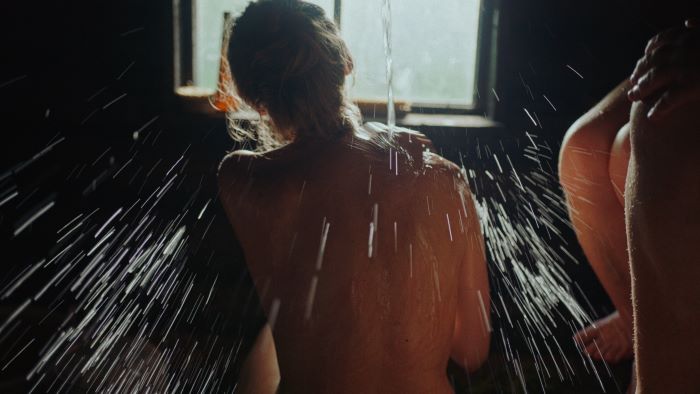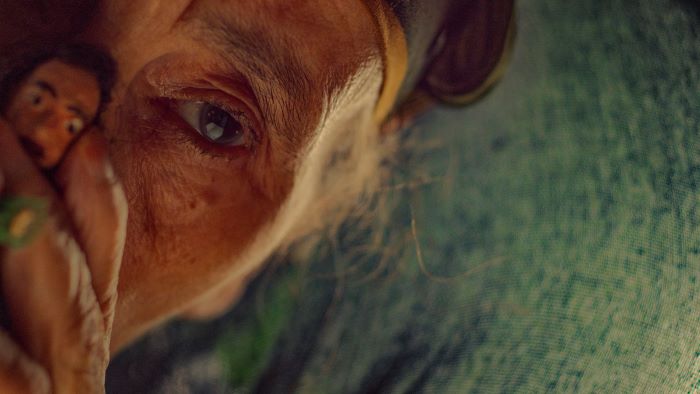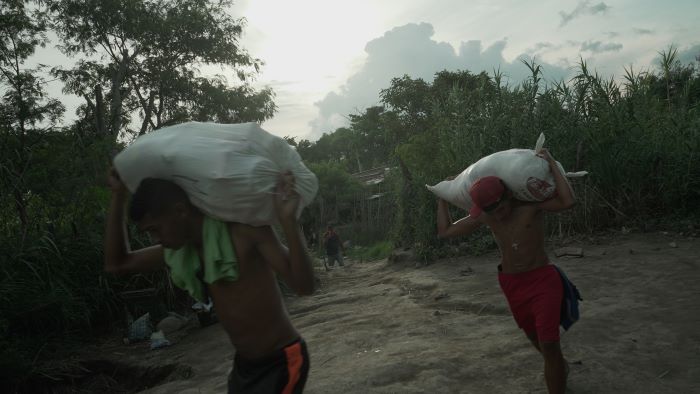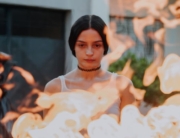The annual DOC NYC festival is stuffed with nonfiction films (114) this year, and it is always heartening to see a selection that is especially diverse, both in nationality and in approach. Here we have Estonia’s submission for the best international film Oscar, Smoke Sauna Sisterhood, as well as Morocco’s, The Mother of All Lies. The third film spotlighted below, the timely At the Border, was filmed in Venezuela and Colombia. The traumas of the past are explored in radically different ways in the first two. The third focuses on the continuing traumas of the present. All are available in the United States on the festival’s online platform.
Spas are traditionally places of rest and relaxation. In southern Estonia, there is a long-standing tradition known as savvusanna kombõ, in which people gather in the darkness of the sauna, leaving their troubles and disagreements outside. The women in Anna Hints’s Smoke Sauna Sisterhood, however, have gathered there for a healing more cleansing and cathartic than the average person is likely to experience. They are engaged in rejuvenating their bodies and in exorcising their sense of shame. They reveal personal histories, use various massaging techniques, sing songs, and intermittently plunge themselves into freezing water. By and large, their stories involve experiencing misogyny of one kind or another. We bear witness to this process, which is slow, like the gradual melting of ice.
Body shame is a recurring subject, and the film is notable most of all for its focus on the human form. The photography is beautiful, period, with exquisite lighting and high contrast shadows. Shots of nature where the vapor in the air, whether from the cold of the outdoors or the heat of the sauna, is visible. Yet there is also incredible imagination in terms of how the bodies are brought to life. There is attention to physical sensations, with close-ups of beads of sweat gathering on skin, of flesh reddening in the heat. More strikingly, it is rare to see a person’s face as she speaks. Often the camera focuses on an unlikely body part (perhaps a shoulder, a flank, a thigh) so that the viewer feels they are seeing humans anew.
Some of the stories told are harrowing and traumatic, others detail small incidents or patterns that developed over time. Fascinatingly, the stories that really land are some of the seemingly innocuous ones, about what a mother used to say, family frustrations regarding when one gets married, and half-funny/half-not stories of mishaps in the bedroom. Perhaps the intimacy of the setting lends stories like this a special weight. At its best, this film is poignant, surprising, and alive.
The traumas of the past are also explored in Mother of All Lies, linked to a specific event: the 1981 Casablanca Bread Riots, in which the Moroccan police shot and imprisoned protestors on the outskirts of the city. There are barely any surviving photographs of the event, and while the government reported a mere 66 casualties, it was later discovered that the death toll was as high as 636. Filmmaker Asmae El Moudir brings her family and a few friends together to revisit this chapter in their lives and in their country’s history. Least cooperative in this cohort is her grandmother, whom El Moudir describes more than once as a tyrant.
The film’s central conceit is a miniature re-creation of the family’s long since vanished neighborhood, built by Moudir and her father, populated by miniature people. There is a figurine for each person in the family (the grandmother hates the one used to represent her), and each building is represented with its interior as faithfully as possible. Sometimes, the family discusses and reminisces as they look at this model. Other times, the camera zooms in, and we hear the sounds of action as we observe the still figures. The effect, at its best, is a poignant attempt to preserve memory against erasure.
There are times this effect is indeed very powerful. Other times, the film gets thoroughly muddled in its conceit. There is too much milling around in the studio where this model is built and too much sensationalized narration for this film to fully maintain its steam. Some of the strongest moments occur when someone outside of the family unit is interviewed, or when El Moudir (who also narrates) takes a more standard documentary approach and the hideous details of the event are more directly discussed. Nevertheless, in very strong scene, a family friend describes his imprisonment and the deaths he witnessed that day, all the while using the figurines to illustrate what happened, all of which justifies El Moudir’s approach. In the face of state-induced forgetfulness, people must be creative in the tools they use to remember.
At the Border brings us face-to-face with political instabilities that have not yet been resolved. Since 2014, Venezuela has been a country in crisis. The nature of said crisis is not extensively analyzed here. Instead, directors Braulio Jatar and Anaïs Michel focus on its effects. The border between Venezuela and Colombia has become a site where some have found a way of life, making their living hustling supplies and people back and forth across the river.
In less than 90 minutes, this film tracks several migrants and manages to create an informative and varied portrait of their lives. Young men chase taxis to get jobs carrying heavy bundles of black-market goods across a border. They wade across a river that frequently overflows and (we are told) drowns people, they live in ramshackle conditions and make barely enough money to live, and save enough to bring relatives or themselves safely to Colombia. Death and violence are alluded to but are left offscreen—presumably because the filmmakers needed to stay safe. (A guide tells the filmmakers where it will be safe to film.) Everyone involved in this trade works with armed groups, and it is as good as a death sentence to wander into the territory of an enemy militia.
The natural world is filmed brilliantly and with an unromantic eye. Though the forests might be beautiful, more often we are focused on slosh, erosion, overflowing rivers, swamps with waist-high water that the young and old must wade through, and the sky is always gray. The same is true of the border town, though in both countries it is striking how alive and alert the people are in spite of the obstacles in question. If we do not see violence. We see the persistent will to survive in precarious situations.
This is a striking documentary, equally at ease portraying these conditions, incorporating necessary political information, and capturing the idiosyncrasies of its principal participants. Life, it is clear, goes on, provided it is allowed to. Yet instability reigns, and asylum, provided surrounding countries are willing to provide it, is clearly the goal.



















Leave A Comment